I have to say I am more excited than usual at the outset of this trip. The journey starts by taking the train from Kaohsiung to Taitung County’s Guanshan Township (關山) on the Puyuma express. This much-improved service only takes a little over two hours, cut down from more than three hours in the past. The plan is to replicate a bike ride I did in 2008 from Taitung to Kaohsiung on the Southern Cross-Island Highway.
Traveling with a touring bike and self-supported, I have everything I need to survive for the three days: camping gear, food, warm clothes and repair equipment.
It’s nearly 10am when the ride starts from Guanshan on Provincial Highway No 9 and the heat is oppressive. The sooner I ride into the mountains, the faster I’ll get out of the sun and onto shaded mountain roads.
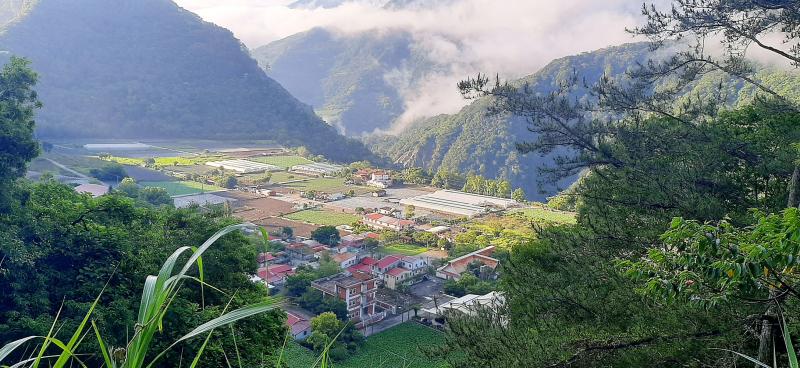
Photo: Mark Roche
MORAKOT’S FURY
Just five kilometers north is the start of Provincial Highway No 20, better known as the Southern Cross-Island Highway. In 2009, Typhoon Morakot caused so much damage and the cost of repairs were so high it’s surprising the road is reopening.
I have to admit that for several years I was skeptical. From about 2015, media reports suggested that the road would open the following year, and every year since then similar announcements would appear — like an annual ritual proclaiming something that would likely never happen.
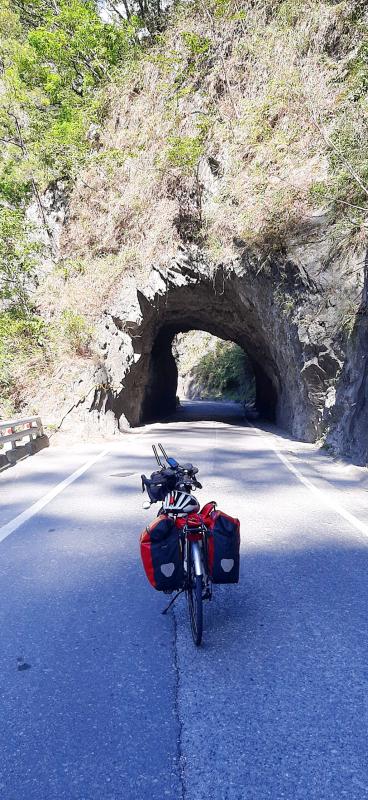
Photo: Mark Roche
As the road starts to ascend I get my first glimpse of the Sinwulu River, (新武呂溪) which flows parallel for almost the entire length of the east side of the road. I pass fields of rice paddies that merge into fruit farms. This part of Taitung County is sparsely populated, with only a handful of indigenous Bunun communities along the way.
After 20 kilometers of riding I come to Wulu Gorge. From the road there is a bird’s eye view of the valley below with pristine water thundering through it. While not as impressive as Hualien County’s Taroko Gorge, this is, in some ways, better because I’m the only person there to enjoy it. The banks of the river are tinged orange from hot spring minerals. A large hotel at this location is really the only major structure on the road.
I continue riding up, no longer worried about the sun, the road twisting and turning through magnificent forest. Every few kilometers the smell of sweet osmanthus wafts across my path and the only thing breaking the silence is the occasional squawk of a Formosan macaque spooked by my intrusion.
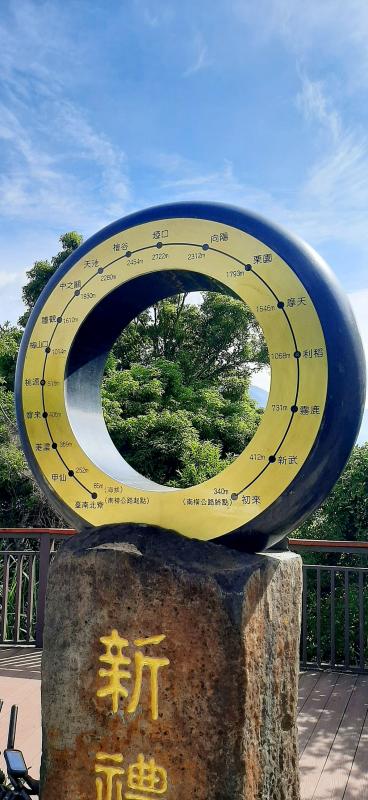
Photo: Mark Roche
It’s nearly 5pm when I arrive at the picturesque town of Lidao (利稻) at an altitude of 1,145m, a perfect location to camp for the night and just high enough to be out of the sweltering heat of the lowlands.
INTO THE CLOUDS
The rainy night has given way to a morning that reveals the high mountains of that day’s destination. Apart from a few tea plantations there is very little on this road by way of places to get refreshments. I have a packed lunch and plenty of liquids to keep me going, but when a passing indigenous farmer hands me a mango I can’t resist.
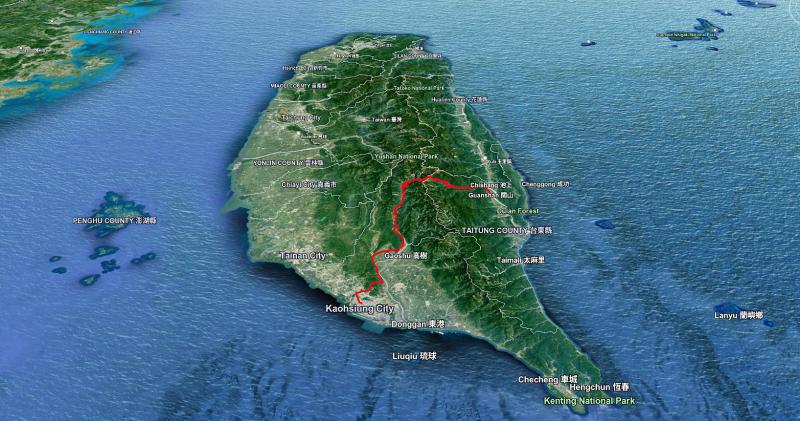
Photo courtesy of Nathan Miller
As I approach the 2,000m mark, I have a clear view of the central mountains. Only 24km to Siangyang National Forest Recreation Area (向陽國家森林遊樂區), but this involves 1,200m of ascent and is slow going. But this is exactly where I needed and wanted to be for the official opening of the Southern Cross-Island Highway on May 1.
When I get up at 5.30am, the camp site is buzzing with people who have traveled from throughout Taiwan to experience the road’s official opening. But there are restrictions. Though this area should primarily be used for recreation, it has access points to high mountain peaks and is one of, if not the best, road in the country for cycling. However, only cars and motorcycles are currently allowed to use it.
HEADACHE FOR HIKERS/CYCLISTS
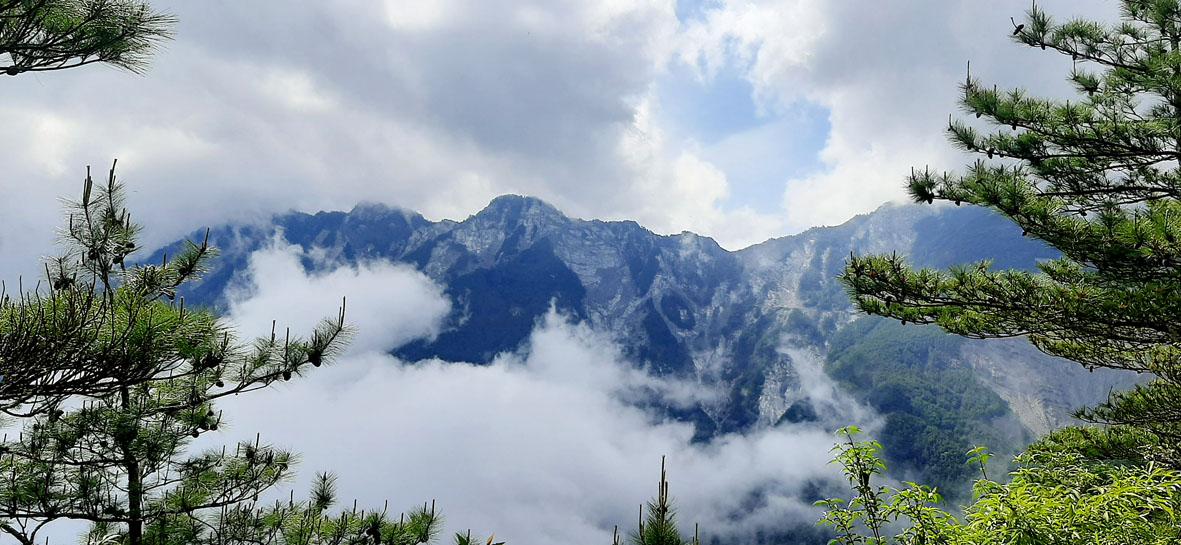
Photo: Mark Roche
In addition, the road is only open daily from 7am to 2pm and all vehicles must be off the road no later than 5pm; it’s closed entirely on Tuesdays and Thursdays. This creates a headache for hikers who can’t always go by the clock on trail. I am hopeful that this will change in the coming months once this soft opening period passes. Today, I can’t ride my bike on the first 20 kilometers between Siangyang and Tianchi, (天池) so some friends help me out by loading it in their a car.
There are cars lined up along the road, but moving along in an orderly fashion. Just 7km away is Daguanshan Tunnel (大關山隧道) and the views are amazing. The lofty peaks of the Central Mountain Range above merge with the sea of clouds below. There are some opportunities to stop for a photo and take in the mountain air, but not for too long. Fear of congestion on the road has traffic wardens urging people to keep moving. Once through the tunnel, it’s 13km down to Tianchi where I assemble my bike for the remainder of the journey.
The road on the west side is quiet at this time, the traffic control on the west is 37km down from Daguanshan tunnel at Meishankou (梅山口) in Taoyuan District (桃源) Kaohsiung. As I roll down in relative quiet I get to enjoy the west side of the highway which is equally spectacular for the mountain views. It is like a return after years of being home sick or visiting an old friend.
The peace and quiet is broken by the approach of cars and large motorbikes racing to the top. But it doesn’t spoil my enjoyment. It’s a 140km ride home to Kaohsiung, not too tiring since most of it is downhill and I am still on a high from what can only be described as an exhilarating experience.

June 2 to June 8 Taiwan’s woodcutters believe that if they see even one speck of red in their cooked rice, no matter how small, an accident is going to happen. Peng Chin-tian (彭錦田) swears that this has proven to be true at every stop during his decades-long career in the logging industry. Along with mining, timber harvesting was once considered the most dangerous profession in Taiwan. Not only were mishaps common during all stages of processing, it was difficult to transport the injured to get medical treatment. Many died during the arduous journey. Peng recounts some of his accidents in

“Why does Taiwan identity decline?”a group of researchers lead by University of Nevada political scientist Austin Wang (王宏恩) asked in a recent paper. After all, it is not difficult to explain the rise in Taiwanese identity after the early 1990s. But no model predicted its decline during the 2016-2018 period, they say. After testing various alternative explanations, Wang et al argue that the fall-off in Taiwanese identity during that period is related to voter hedging based on the performance of the Democratic Progressive Party (DPP). Since the DPP is perceived as the guardian of Taiwan identity, when it performs well,

The Taiwan People’s Party (TPP) on May 18 held a rally in Taichung to mark the anniversary of President William Lai’s (賴清德) inauguration on May 20. The title of the rally could be loosely translated to “May 18 recall fraudulent goods” (518退貨ㄌㄨㄚˋ!). Unlike in English, where the terms are the same, “recall” (退貨) in this context refers to product recalls due to damaged, defective or fraudulent merchandise, not the political recalls (罷免) currently dominating the headlines. I attended the rally to determine if the impression was correct that the TPP under party Chairman Huang Kuo-Chang (黃國昌) had little of a

A short walk beneath the dense Amazon canopy, the forest abruptly opens up. Fallen logs are rotting, the trees grow sparser and the temperature rises in places sunlight hits the ground. This is what 24 years of severe drought looks like in the world’s largest rainforest. But this patch of degraded forest, about the size of a soccer field, is a scientific experiment. Launched in 2000 by Brazilian and British scientists, Esecaflor — short for “Forest Drought Study Project” in Portuguese — set out to simulate a future in which the changing climate could deplete the Amazon of rainfall. It is